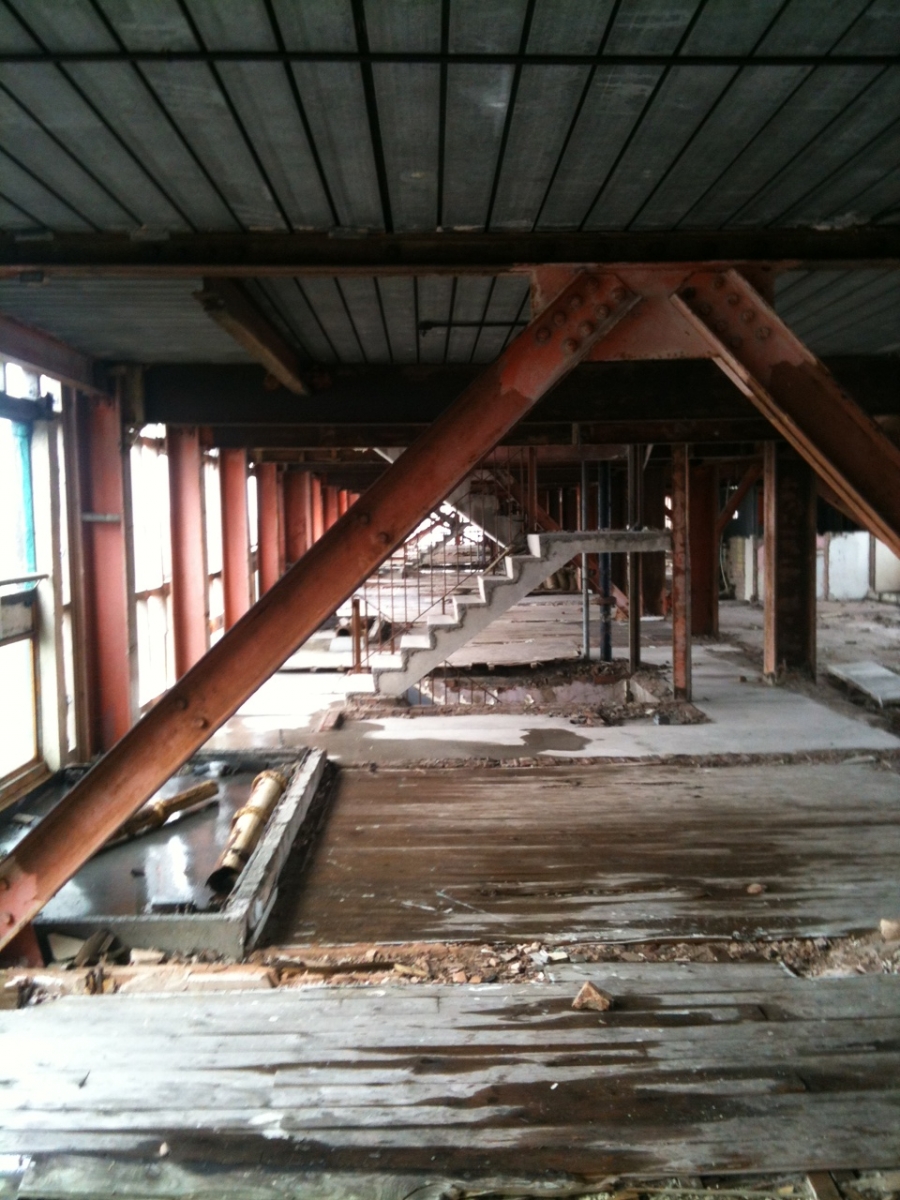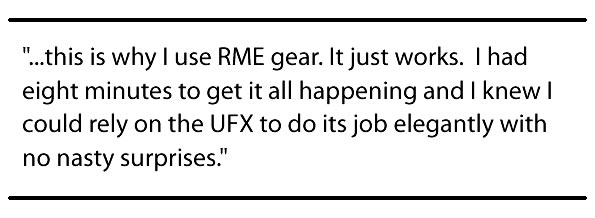Envelope-pushing audio guru, sound engineer and RME Fireface UFX user Matt Saunders has been busy turning the 27 storey Red Road tower block in Glasgow into an enormous soundscape.
Read on for his entertaining account of the unique challenges involved…
“It’s bigger than I expected”, I said in a slightly squeaker voice than I had intended. “I don’t think the EV S200s are really going to hack it”
I was standing in front of a gutted residential tower block in the north east of Glasgow, part of the Red Road estate, put up in the sixties and heralded as the new way of living. The soviet states all sent their architects there to learn of the new paradigm in architecture. It must be observed that they learnt their lesson well.
Once the tallest residential development in Europe and the icon for social development across the world, Red Road became a dumping ground for all those that the authorities didn’t want to see, understand or have anything to do with and was left to run down until it was no better than the tenements it was intended to replace.
These thoughts whirled through my head as I contemplated the 27 storey high, 110m wide structure, now vacant of people, walls and windows and began to realise that I was going to have to respecify everything.
Everything, that is, apart from my RME Fireface UFX. That and my battered old HP laptop.
The project was to turn the block into a sound sculpture for a day as the next instalment of an on going, if sporadic, series of multimedia events called ‘Future Memory’.
My intention was to use, or probably more accurately misuse, ambisonics to spread a soundscape across the front of the building. The brief (a phone call) had been sparse, involving the words ‘tower block’ and ‘sound sculpture’ but not ‘gargantuan monolith’ or ‘bloody great lump of steel and concrete’ and this had lead me sorely to underestimate the scale and majesty of the building.
The sounds were to be interviews with past residents of the estate, songs and games collected from the local schools and social clubs, the noise of the local environment and the fabric of the block itself. These were to weave across the front of the building so as to bring it to life again for one last afternoon to celebrate all that was happy, fun and beautiful about life in what was generally considered, mainly by outsiders, to be a disaffected, run down and undesirable place to live.
I was put in touch with the glorious leader of the Glasgow branch of Cameron Presentations, who turned out to be the inestimable Campbell MacLeod, two clans in one man very handy for social gatherings. He quickly grasped the social and political significance of the project, not to mention the sheer barking insanity of it, and settled down with me to spec up speakers, amps and ting. Without the professionalism, dedication and inventiveness of Campbell and his team the project might never have got off the drawing board.
We decided, after much discussion, to use 10 stacks of d&b Q7, fed by d&b D12 amps, in two horizontal rows of five across the front of the building. I would like to have placed them in more of a circle but the, perfectly understandable, health and safety constraints of the demolition contractors meant we couldn’t take equipment above the top blast floor. Oh yes, blast floor. I may have omitted to mention that the block has been stripped for demolition for a couple or more years. But for the presence of a pair of peregrine falcons that have made it home, feasting royal on the fine crop of pigeons and rats that now inhabit it, the monolith would have been long toppled.
These were to be fed directly by the UFX with a Presonus DigiMax Fs giving the last pair of balanced outs. The UFX was connected via FireWire to the laptop which ran TotalMix FX and AudioMulch, a wonderful audio performance engine, created by Ross Benicia. The Presonus was ADATed to the UFX and clocked on the BNC.
I wanted to achieve a mixture of well located and more diffuse sound sources so I decided to use a mixture of 1st order and 3rd order ambisonic techniques, the 3rd order giving good accurate location and the 1st more of a wash.
AudioMulch was the processing heart of the rig. It handled the playing of sound files, the i/o necessary for the live sound sources, gain regulation and all of the ambisonic panners, rotators, encoders and decoders in the form of VST plugins. Some of these were freeware, written by the fair hand of Dr. Bruce Wiggins of Derby University under the moniker WigWare, others were custom written for the performance by the aforementioned and still more by Richard Furse of Blue Ripple Sound, he of the Furse Malham equations.
The UFX and AudioMulch were then to be controlled over wifi from an iPad (other tablets are available) so as I could stand with the audience in front of the building and sculpt from there. The UFX was controlled with TouchOSC using the jolly good template that Matthias and the chaps at RME wrote. AudioMulch, which I fear has yet to use OSC, was controlled using TB Midi Stuff and rtpmidi midi bridge. TB Midi Stuff has one great advantage over TouchOSC in that the template editor is built into the app, which for constantly evolving live performance controllers is useful, to say the least, when artistic and logistic demands have you and the composer/curator awake at 3:00 am, on the day of the performance, mutating the instrument and moulding it to suit our desires.
The composer/curator was Dr. Marion Wood, past head of music at Exeter University and though we have known each other more years than is proper to reveal, our schedules had not allowed us to do more than Skype until we were both sitting in a hotel room in Glasgow with the Damacletian deadline of the performance hanging over us.
So the day dawned and, less bright eyed and bushy tailed than I, or Marion, would have hoped, we gathered at the block to make it happen. Due to site security issues we had not been able to rig any of the equipment prior to the event so everything had to work first time.
This brings me to my first lesson to impart. When working in stripped out tower blocks with no lifts left, only one staircase and running off generators used by the demolition contractors, always take a photo of the generator when trying to acquire the cable to feed a lot of amps on the ninth floor of a building 50m away from the generator. This rule came to me as I contemplated the single phase 63 amp socket in the side of the generator and the 3 phase 63 amp plug in my hand. This conundrum was solved by finding a 3 phase supply in a yet to be de asbestosed block 400m away. We did have to borrow the cable from the 32 storey moving access platform to reach it. By the way, 100m 3 phase 63 amp cables are very heavy, long before you reach the ninth floor, trudging up the stairs.
Electricity supplied I am brought to my second lesson. Be ruthless with your composer. I had scheduled 2 hours for getting the wrinkles out of the rig before the performance was to start. I finally got the laptop and the audio rack 10 minutes before zero hour. Sound files were still being wrangled and composition was still being performed until the last minute in a nearby community centre.
I crossed the 1/3 of a mile and scaled the heights of the blast floor in record time. And this is why I use RME gear. It just works. I had eight minutes to get it all happening and I knew I could rely on the UFX to do its job elegantly with no nasty surprises. The Cameron’s team have every cable laid out in sequence and before the laptop has booted all the hardware is connected. Now for the wifi.
Allow me a flight of fancy. Imagine a world where networks just worked, name spaces and address spaces walk hand in hand in Elysian Fields. A world where everyone talks the same protocols, say OSC, and things just work. A world where wifi midi bridges are a quaint notion like alchemy.
Suffice to say after many reboots of iPads, wifi switches and software restarts everything finally flickered its own sweet message of love and then I was left with a dilemma. Mix the event from the blast floor or risk loosing the wifi signal as I run down the only remaining, steel enclosed, like some faraday cage, stairway.I took the third option and asked Rab, our demolition contractor liaison, to lower my ipad-containing shoulder bag nine stories down the front of the building on a rope whilst I legged it down the stairs. Reunited at the bottom I still had a connection and we were ready to weave.
And we did. We started only one minute late and, though ‘the rain slammed hard as bars’ (Joni Mitchell) and a pair of minor waterfalls cascaded off our hard hats, Marion and I succeeded in our mission and the building sang.
Now for the Oscar speech. None of this would have been possible without the funding and support of Glasgow and Exeter universities. The same goes for Street Level Photographic Studios, where the wonder who is Iseult Timmermans creates and works. She was the project coordinator and our earth strap, grounding us with a healthy dose of reality when our flights of fancy soared unfeasably high. And then there is Safedem, the demolition contractors and Rab and his team. They allowed us more freedom than I would have considered possible and provided the 500m of cable that enabled us to get power to our equipment when all else failed. Apex Generators came up trumps by loaning us all the distribution boxes and cable we needed to route the power to the necessary locations. Ralph Dunlop at Sound Network for the loan of various DPA microphones. Bruce Wiggins at Derby University for his coding and plugins. I could waffle on endlessly but I will draw the line by saying that anyone who feels forgotten or left out has my heartfelt thanks.
Finally I must thank the pair of peregrine falcons, without whom there would be no shell of a building (and I wouldn’t have got the chance to play with an icon of failed social engineering).
Matt Saunders
Our thanks to Matt for providing the words for this article.
Find out more about the RME Fireface UFX

























